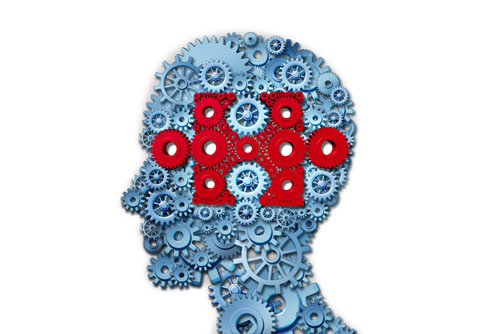
Scientists at Rutgers University have discovered that the protein involved in the proliferation and differentiation of neural progenitor cells—specifically p75 neurotrophin receptor (p75NTR)—may also influence the development of autism. This protein is responsible for the cell cycle regulation of neuronal cells in developing brain tissue, and when it is missing scientists have found excessive neuronal cell numbers, a condition associated with autism-like symptoms, in rodent models.
Development of brain circuitry requires precise regulation and timing of neural progenitor cells. The p75NTR protein is highly expressed in the proliferating granule cell precursors during development of the cerebellum, and is needed to generate new brain cells during prenatal and early childhood development. Without it, the brain cannot develop correctly.
Working in the laboratory with genetically engineered mice, the Rutgers scientists found that mice without the p75NTR protein had more brain cells than should normally exist—causing problems in the cerebellum, the part of the brain that regulates movement and balance as well as cognitive function, characteristic of autism spectrum disorder.
Scientists observed deleterious effects on cerebellar circuit development in rodents missing the gene, and found the behavioral consequences persisted into adulthood, particularly cerebellum-dependent forms of learning. These results demonstrate the necessity of appropriate developmental timing of the cell cycle for establishment of proper connectivity and associated behavior.
Cerebellar function is found to be disrupted in a variety of psychiatric disorders, including those on the autism spectrum.
“During brain development, there is a coordinated series of events that have to occur at the right time and the right place in order to establish the appropriate number of cells with the right connections,” said Juan Pablo Zanin, a research associate at Rutgers and the lead author on the study published in the Journal of Neuroscience. “Each of these [development] steps is carefully regulated, and if any of these steps are not regulated correctly, this can impact behavior.”
Zanin has been working with Wilma Friedman, professor of cellular neurobiology who is also studying the p75NTR protein and its involvement in regulating cell division. Both scientists hope to determine p75NTR exact function in brain development, in order to better understand how this genetic mutation could cause brain cells to die off, and discover if p75NTR can be considered a direct genetic link to autism or neurological diseases like Alzheimer’s.
“This protein has been examined in regard to neurodegeneration as occurs in Alzheimer’s disease and cell death after brain injury,” said Friedman, coauthor of the study. “But it has not been looked at regarding the importance it has in generating new neurons.”
In the study, researchers trained mice—those genetically modified to be lacking the p75NTR protein and normal mice—to associate a quick puff of air with a blinking light. Mice with the protein learned to blink and shut their eyes when they saw the light, but mice without the protein did not.
Other scientific studies have found this same learning deficit in mice with mutations in genes that are directly associated with autism.
According to the Centers for Disease Control and Prevention, about one in every 59 children in the U.S. is diagnosed with autism, up from one in every 150 in 2000. Although symptoms vary, the disorder causes difficulties in social interactions with others, and often results in repetitive behaviors, speech issues, memory problems and difficulties in understanding non-verbal cues.
Scientists have no clear answer as to the consequences of a brain with too many neurons. Autism, which is seen primarily a genetic disease, has been associated with an unusually large brain size and some scientists believe early brain overgrowth could be a marker for the disorder.
“It is important to understand how the brain’s circuitry is built and how it regulates behavior normally,” said Friedman. “This research shows us that when it is not generated properly it is going to have an impact on many behaviors.”
While it is somewhat difficult to compare human and rodent brain development, particularly on a cellular and behavioral level, p75NTR could very well play a large role in our understanding of autism development and behaviors in human children, and lay the groundwork for future studies.











